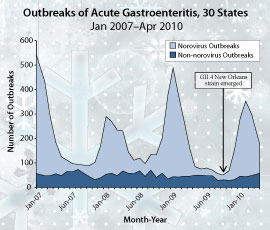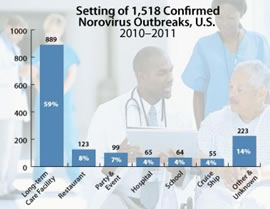Trends and Outbreaks
Trends
Each year, norovirus—
- causes about 21 million cases of acute gastroenteritis (inflammation of the stomach or intestines or both)
- contributes to about 70,000 hospitalizations and 800 deaths, mostly among young children and the elderly
You can get norovirus illness at any time during the year. But, it is most common in the winter. Also, there can be 50% more norovirus illness in years when there is a new strain of the virus going around.
Outbreaks
Most outbreaks of norovirus illness happen when infected people spread the virus to others. But, norovirus can also spread by consuming contaminated food or water and touching things that have the virus on them.
Healthcare facilities, including nursing homes and hospitals, are the most commonly reported places for norovirus outbreaks in the United States and other industrialized countries. Nearly two-thirds of all norovirus outbreaks reported in the United States occur in long-term care facilities.
Outbreaks of norovirus illness have also occurred in restaurants, cruise ships, schools, banquet halls, summer camps, and even at family dinners. These are all places where people often eat food handled or prepared by others.
In fact, norovirus is the leading cause of illness from contaminated food in the United States. About 50% of all outbreaks of food-related illness are caused by norovirus.
Foods that are commonly involved in outbreaks of norovirus illness are—
- leafy greens (such as lettuce),
- fresh fruits, and
- shellfish (such as oysters).
But, any food that is served raw or handled after being cooked can get contaminated.
To search for foodborne outbreaks caused by norovirus, go to the Foodborne Outbreak Online Database (FOOD).
Norovirus outbreaks have also been caused by contaminated water from sewage in wells and recreational water, such as pools.
Learn more about norovirus
Resources for Public Health Practitioners
- Updated Norovirus Outbreak Management and Disease Prevention Guidelines (2011)
- Guideline for the Prevention and Control of Norovirus Gastroenteritis Outbreaks in Healthcare Settings (2011)
- A Norovirus Outbreak Control Resource Toolkit for Healthcare Settings (2012)
- CDC Data & Statistics Feature: Surveillance for Norovirus Outbreaks
- Surveillance Summaries for Waterborne Disease and Outbreaks
For more information, see the “For Public Health Professionals” section of this Web site.
Images and logos on this website which are trademarked/copyrighted or used with permission of the trademark/copyright or logo holder are not in the public domain. These images and logos have been licensed for or used with permission in the materials provided on this website. The materials in the form presented on this website may be used without seeking further permission. Any other use of trademarked/copyrighted images or logos requires permission from the trademark/copyright holder...more
![]() This graphic notice means that you are leaving an HHS Web site. For more information, please see the Exit Notification and Disclaimer policy.
This graphic notice means that you are leaving an HHS Web site. For more information, please see the Exit Notification and Disclaimer policy.
Contact Us:
- Centers for Disease Control and Prevention
1600 Clifton Rd
Atlanta, GA 30333 - 800-CDC-INFO
(800-232-4636)
TTY: (888) 232-6348 - New Hours of Operation
8am-8pm ET/Monday-Friday
Closed Holidays - cdcinfo@cdc.gov





